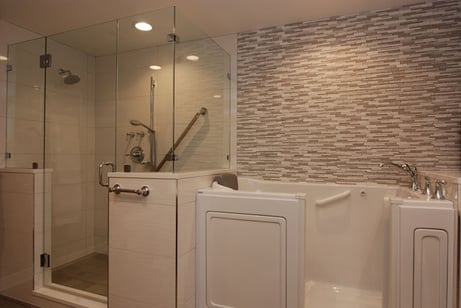 Walk-in tub innovations have taken a product that was historically “great in theory,” propelling it to a desirable feature in accessible Chicago bathroom remodels.
Walk-in tub innovations have taken a product that was historically “great in theory,” propelling it to a desirable feature in accessible Chicago bathroom remodels.
Like all things, these use-specific bathtubs have their pros and cons – whether or not the pros outweigh the cons for your bathroom design depends on a few key factors.
Safety is a need, not a want
If you’re in a wheelchair and/or rely heavily on mobility aids for safety and movement, the pros of a walk-in tub may outweigh the cons.
The right walk-in tub model ensures you can enter and exit the tub safely, have quick-fill options so you don’t have to sit in a water-free zone for long, and offer all kinds of features to enhance your bath experience – taking it from functional to therapeutic.
Read, Luxury Features of a Walk-In Tub, to learn more.
Is there enough in your budget?
If you’re designing a luxury bathroom, this won’t be an issue. Those with a strict budget, though, may want to forgo the installation of a walk-in tub. These tubs are significantly more expensive than standard soak or Jacuzzi tubs so it may blow your bathroom budget.
If budget is an issue for you, consider designing a curb-free, walk-in shower instead, and talk to your bathroom designer about bonus features, like steam shower options, comfortable seating, hand-held faucets and other plumbing accessories that will simulate the relaxing and therapeutic benefits of a soak tub.
You don’t have a medical issue that puts you at risk while bathing
Walk-in tubs are designed to remain firmly shut until the water has drained. This reasonable design feature is a potential negative should you experience a medical emergency while inside the tub. Similarly, if your mobility and/or strength are compromised to the point that you require lateral sliding transfers between seats, walk-in tub designs make this challenging.
If an existing health conditions put you at risk for heat-related complications, talk to your doctor about whether or not a walk-in tub is right for you. If someone lives with you and is at the ready to assist you and/or you have a Life Alert (or similar) safety system in place, the risk may not be much at all. If you live alone, however, these tubs may not be the best option for you.
You have a sufficient water heater and plumbing for quick drainage
Odds are, your Chicago bathroom design-builder has already inspected your water heater. If s/he found it lacking, a new one is already on order. It’s worth mentioning, though, that walk-in tubs often use more water than traditional tubs because they are quite deep and their quick-fill function requires rapid and ample access to hot water. Similarly, the quick-drain options rely on higher-quality plumbing that can accommodate the speculated velocity of the water flow.
Note: We’ve mentioned the quick-fill/drain options twice now. In case you’re new to the concept, walk-in tubs require the bather to enter the bath, shut the door, and then fill the tub. Make sure you look for heated seat, heated backrests and other features that will keep you warm in the duration.
Still not sure whether or not a walk-in tub is the right choice for you Chicago bathroom design? Contact us here at Kitchens & Baths Unlimited. Our design professionals can run through these and other considerations to determine whether or not the pros outweigh the cons for your household.



